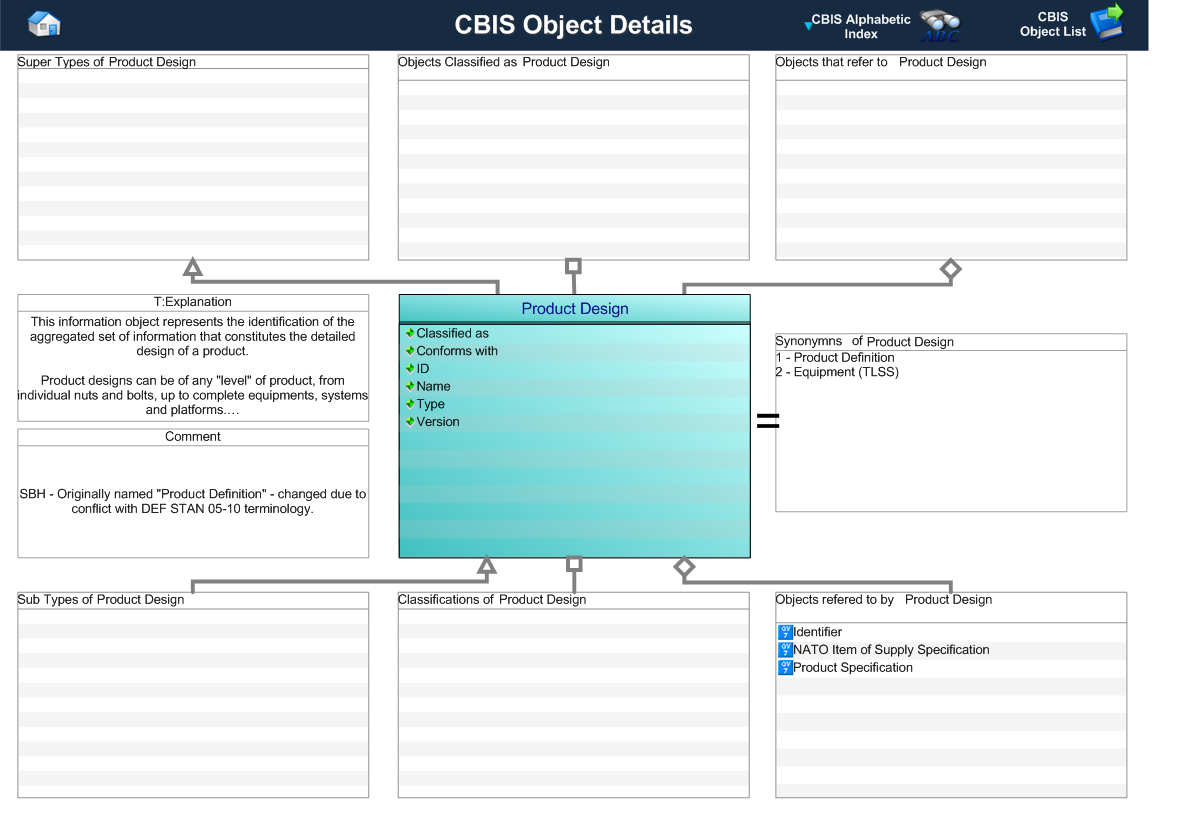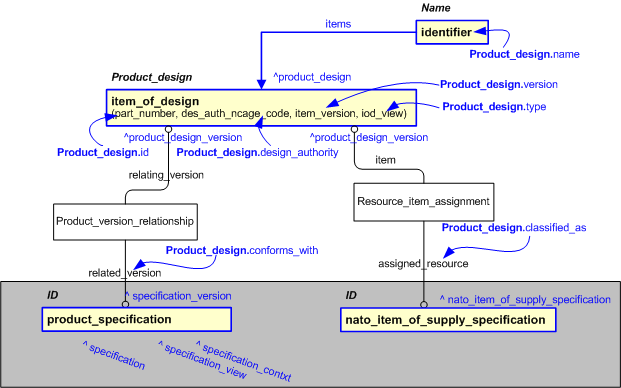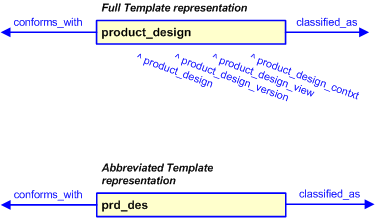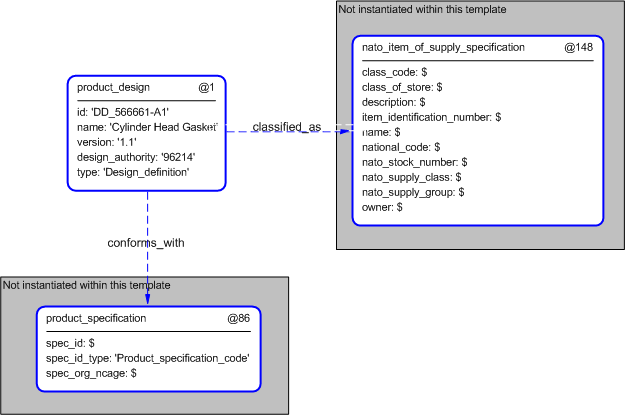Template:— product_design (prd_des)
Context:— UK_Defence |
Date: 2009/10/28 17:11:54
Revision: 1.4
|
This section specifies the template product_design.
NOTE
The template has been defined in the context of
UK_Defence.
Refer to the business context for details of related templates.
NOTE
An explanation of a template and the associated instantiation path is
provided in the
Template overview
section.
This template describes how to represent the information requirements of a UK_Defence Product Design object. Product designs
can be of any "level" of product, from individual nuts and bolts, up to complete equipments, systems and platforms.
Product designs are typically identified by a design authority part number, and when fully specified, may have a detailed
drawing/product model associated with them that contain the level of detail that enables instances of the physical elements
of the design to be manufactured and/or assembled.
Product designs will typically also have associated performance specifications, physical characteristcs (such as dimensions,
weight and material specifications), and other charateristics such as cost.
The product design process may involve specification of functions, conceptual physical design/general layout design and identification
of spatial zones within the design.
This information object is not meant to contain the detailed design information objects themselves (the goemetry, topology,
dimensions, tolerances, material specification, surface finishes etc). It is meant to act as the single reference point to
which all that other information relates.
This information object represents the information about a Product Design.
Figure 1 — A MOOD Business Architect representation of the Business Object: Product Design
The attributes of the Product Design object are tabled below.
|
Attribute name
|
Attribute description
|
Attribute type
|
Optionality
|
| Classified as |
This is the reference to the NATO item of supply specification that may classify this product design. This enables the NSN
- Part Number relationships to be established.
|
Relationship (to Nato Item of Supply Specification) |
Optional |
| Conforms with |
This is a specification that the design conforms to, such as the specification attached to an item in a catalogue. There may
be zero, one or many specifications that the Product Design conforms with.
|
Relationship (to Product Specification) |
Optional |
| ID |
This is the identifier of the Product Design. There should be at least one identifier for the Product Design. |
Identifier |
Mandatory |
| Name |
This is the name of the Product Design. There should be at least one name for each Product Design. |
intrinsic |
Mandatory |
| Type |
This is the type of the Product Design. Each Product Design can only be of one type. |
Identifier |
Mandatory |
| Version |
This is an indentifier of the version of the product design. There may be one or many versions for each Product Design. |
intrinsic |
Mandatory |
Table 1 — Product attribute details
The EXPRESS-G diagram in
Figure
2
shows the templates and EXPRESS entities that are required
to represent the template
"product_design".
The text highlighted in blue shows the template parameters.
This information object represents the aggregated set of information that constitutes the design of a product.
Figure 2 — EXPRESS-G style representation of the Information model for product_design
The graphic for the template to be used in other EXPRESS-G diagrams
is shown in Figure
3
below.
Figure 3 — The graphical representation of the product_design template
The following input parameters are defined for this template:
The item id (part number)
The version number(part vn number)
The ncage identifier of the design authority that provides the part number. Is refered to as the id source organization elsewhere.
type (Default=Design_definition,Type='CLASS')
The product specification that the design conforms to.
The nato item of supply specification that the design can be classified as.
The following reference parameters are defined for this template:
Allow the
Part
entity instantiated in this path to be referenced when this template is used.
Note: The
Part
entity can be referenced in a template path by:
%^target = $product_design.product_design%
where
target
is the parameter to which the
Part
is bound.
Allow the
Part_version
entity instantiated in this path to be referenced when this template is used.
Note: The
Part_version
entity can be referenced in a template path by:
%^target = $product_design.product_design_version%
where
target
is the parameter to which the
Part_version
is bound.
Allow the
Part_view_definition
entity instantiated in this path to be referenced when this template is used.
%^target = $product_design.product_design_view%
%^target = $product_design.product_design_contxt%
The instantiation path shown below specifies the entities that are to be
instantiated by the template.
A description of templates and the syntax for the instantiation path is
provided in the
Templates Help/Information section.
The instance diagram in Figure
4
shows an example of the EXPRESS entities and templates that are instantiated by the template:
/product_design(id='DD_56661-A1', name='Cylinder Head Gasket', version='1.1', design_authority='96214', type='Design_definition')/
(an illustration of the consolidated product_design template is shown in
Figure
5 below.)
Figure 4 — Entities instantiated by product_design template
The instance diagram in
Figure
5
shows the graphic symbol for the template that is to be
used in other instance diagrams. The example template is:
/product_design(id='DD_56661-A1', name='Cylinder Head Gasket', version='1.1', design_authority='96214', type='Design_definition')/
Figure 5 — Instantiation of product_design template
Characterizations
No common characterizations of the template
product_design
have been identified. However, the ISO 10303-239 EXPRESS model
may enable other assignments to the entities instantiated by the template.




